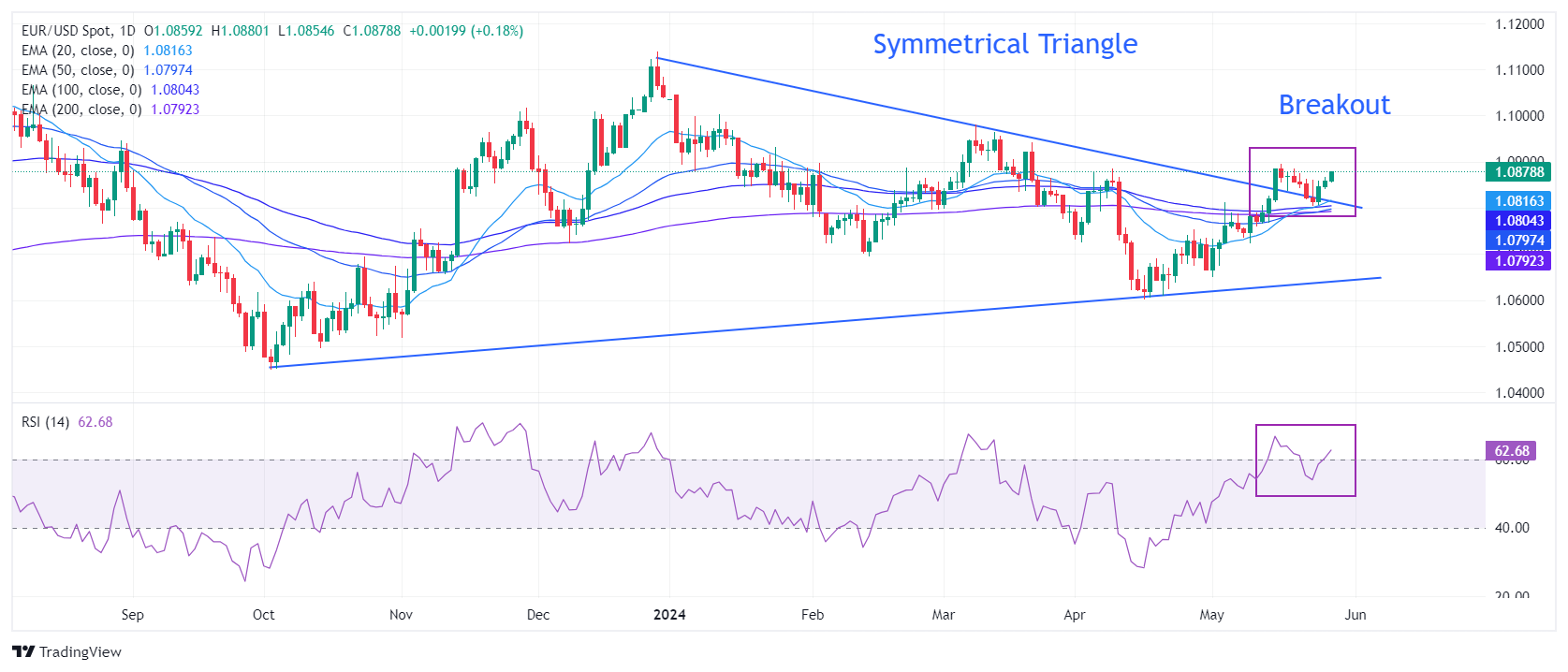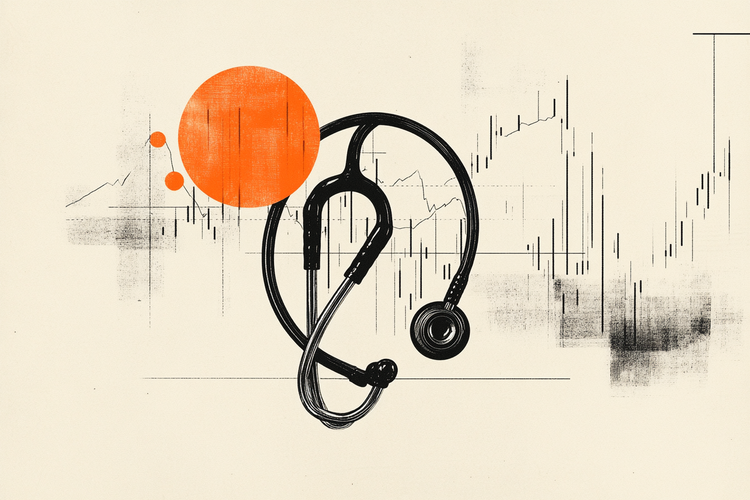- EUR/USD rises further to 1.0880 as the US Dollar extends its decline.
- The US dollar weakens even as investors see the Fed normalizing policy in the final quarter of the year.
- ECB policymakers refuse to commit to further rate cuts after June.
EUR/USD marks a new weekly high at 1.0880 in the European session on Tuesday. EUR/USD strengthens amid weakness in the US Dollar (USD) and growing uncertainty over the pace at which the European Central Bank (ECB) will cut key interest rates after the June meeting.
The US Dollar Index (DXY), which tracks the value of the US dollar against six major currencies, extends its decline to 104.40. The US dollar is facing pressure even though investors' expectations that the Federal Reserve (Fed) will cut interest rates starting from the September meeting have faded significantly. CME's FedWatch tool shows that the probability of the Fed maintaining the current policy framework in September has increased to 50% compared to about 35% seen a week earlier.
The strong United States (US) economic outlook and policymakers' hawkish guidance on interest rates have forced traders to reduce their bets on rate cuts. This week, market speculation on Fed rate cuts will be guided by April core Personal Consumption Expenditure (PCE) Price Index data, due out on Friday. Core PCE inflation data, which is the Fed's preferred measure of inflation, is estimated to have remained stable on a monthly and annual basis.
Market Drivers: EUR/USD Capitalizes on US Dollar Weakness
- EUR/USD extends its winning streak for the third consecutive trading day on Tuesday. EUR/USD jumps to 1.0880 as debate deepens over the path of rate cuts by the European Central Bank. The ECB is set to deliver an interest rate cut at its June 6 monetary policy meeting, barring any surprises. Investors are therefore discussing to what extent and at what pace the ECB will ease its monetary policy after June.
- ECB policymakers refuse to commit to a predefined path of rate cuts, preferring to rely on data. Meanwhile, market speculation about the ECB's full-year rate cuts has also taken a hit, as some policymakers have warned that adopting an aggressive easing policy could reignite price pressures. Investors now expect the ECB to reduce key borrowing costs once again after June. A week ago, investors were expecting three rate cuts in 2024, while at the start of the year they were expecting six rate cuts.
- On Monday, ECB policymaker and French central bank governor François Villeroy de Galhau said in an interview with German newspaper Boersen Zeitung that the June rate cut is a fact and discussions revolve around how far and interest rates will drop quickly. Villeroy rejected suggestions of a quarterly rate cut, saying: “I'm not saying we should commit already in July, but let's maintain our freedom over the timing and pace.”
- On the same day, ECB chief economist Philip Lane said in a speech in Dublin that the pace at which interest rates will be cut depends on the strength of underlying demand for inflation, Reuters reported. The absence of upside surprises in inflation and demand will allow the ECB to deploy an aggressive rate-cutting approach, while upside risks to inflation and demand would force the ECB to reduce interest rates gradually.
- This week, the main trigger for Euro price action will be preliminary Eurozone inflation data for May, which will be released on Friday. Inflation data will provide new clues as to whether the ECB will extend the rate cut cycle into July. But before that, investors will focus on the preliminary May inflation reading for Germany, due out on Wednesday. Headline and harmonized monthly inflation is expected to have grown at a slower pace of 0.2%. Annual headline inflation is estimated to have accelerated to 2.7% from 2.4% in April.
Technical Analysis: EUR/USD marks new weekly high at 1.0880
EUR/USD rises to 1.0880 ahead of crucial Eurozone/US inflation data The pair indicates broader strength as it firmly holds the breakout of the symmetrical triangle chart pattern formed on a daily time frame.
The short-term outlook for the shared currency pair remains firm as it is trading well above all short- to long-term EMAs.
The 14-period RSI has fallen into the 40.00-60.00 range, suggesting that the momentum, which was leaning towards the upside, has moderated for now.
The main currency pair is likely to regain a two-month high around 1.0900. A decisive break above this level would take the pair towards the March 21 high around 1.0950 and the psychological resistance of 1.1000. However, a downside move below the 200-day EMA at 1.0800 could push it further lower.
The Euro FAQs
The Euro is the currency of the 20 countries of the European Union that belong to the euro zone. It is the second most traded currency in the world, behind the US dollar. In 2022, it accounted for 31% of all foreign exchange transactions, with an average daily volume of more than $2.2 trillion per day. EUR/USD is the most traded currency pair in the world, accounting for an estimated 30% of all transactions, followed by EUR/JPY (4%), EUR/GBP (3%) and EUR/AUD (2% ).
The European Central Bank (ECB), headquartered in Frankfurt, Germany, is the reserve bank of the euro zone. The ECB sets interest rates and manages monetary policy The ECB's main mandate is to maintain price stability, which means controlling inflation or stimulating growth. Its main instrument is to raise or lower interest rates. Relatively high interest rates – or the expectation of higher rates – tend to benefit the Euro and vice versa. The Governing Council of the ECB takes monetary policy decisions at meetings held eight times a year. Decisions are made by the heads of the eurozone's national banks and six permanent members, including ECB President Christine Lagarde.
Eurozone inflation data, measured by the Harmonized Index of Consumer Prices (HICP), are an important econometric data for the euro. If inflation rises more than expected, especially if it exceeds the 2% target set by the ECB, it is forced to raise interest rates to bring it back under control. Relatively high interest rates compared to their peers tend to benefit the Euro, as it makes the region more attractive as a place for global investors to park their money.
Data releases measure the health of the economy and can influence the Euro. Indicators such as GDP, manufacturing and services PMIs, employment and consumer sentiment surveys can influence the direction of the single currency. A strong economy is good for the Euro. Not only does it attract more foreign investment, but it may encourage the ECB to raise interest rates, which will directly strengthen the Euro. Conversely, if economic data is weak, the Euro is likely to fall. The economic data for the four largest economies in the eurozone (Germany, France, Italy and Spain) are especially significant, as they represent 75% of the eurozone economy.
Another important release for the euro is the trade balance. This indicator measures the difference between what a country earns from its exports and what it spends on imports during a given period. If a country produces highly sought-after export products, its currency will appreciate due to the additional demand created by foreign buyers wishing to purchase these goods. Therefore, a positive net trade balance strengthens a currency and vice versa for a negative balance.
Source: Fx Street
I am Joshua Winder, a senior-level journalist and editor at World Stock Market. I specialize in covering news related to the stock market and economic trends. With more than 8 years of experience in this field, I have become an expert in financial reporting.








